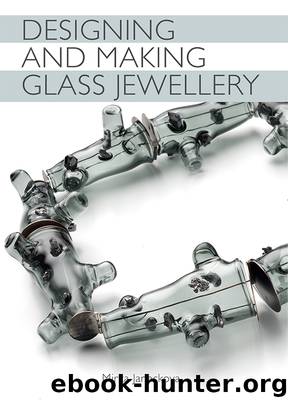Designing and Making Glass Jewellery by Mirka Janeckova

Author:Mirka Janeckova
Language: eng
Format: epub
Publisher: Crowood
Open and closed moulds. The open mould is much simpler but is suitable only for items with no undercuts and the result would always have a flat back. More complex shapes need to be cast in closed moulds.
First, we will look at how to make your master model and then we progress into mould making and finally filling the mould with the raw glass material.
Making a Wax Master Model: Traditional and Digital Methods
You may choose to carve or sculpt your master directly in wax. This would be the easiest way but you would be able to use the shape only once as it will disappear in the process (hence the name ‘lost’ wax casting). There are specialist waxes for glass casting which are designed for this process but you may choose to experiment with other kinds.
If you have previously carved wax for metal castings then don’t expect the glass to be able to reproduce such fine detail as metal. The glass naturally rounds itself when heated unless it is forced into a different shape. Have you ever watched the water spilled on a flat surface? The water has a tendency to form rounded edges and any droplets repeat this on a smaller scale. Glass has a similar behaviour: it doesn’t like to form sharp edges when heated. There are some techniques which help to overcome this, as we will discuss later.
Download
This site does not store any files on its server. We only index and link to content provided by other sites. Please contact the content providers to delete copyright contents if any and email us, we'll remove relevant links or contents immediately.
| Beadwork | Jewelry |
| Rock & Gem Crafts |
On Writing A Memoir of the Craft by Stephen King(4660)
The Doodle Revolution by Sunni Brown(4500)
A Simplified Life by Emily Ley(3965)
Mummy Knew by Lisa James(3519)
Marijuana Grower's Handbook by Ed Rosenthal(3508)
Better Homes and Gardens New Cookbook by Better Homes & Gardens(3368)
Paper Parties by Erin Hung(3306)
Figure Drawing for Artists by Steve Huston(3267)
Draw Your Day by Samantha Dion Baker(3124)
The Genius of Japanese Carpentry by Azby Brown(3033)
Japanese Design by Patricia J. Graham(2997)
The Code Book by Simon Singh(2855)
Lions and Lace by Meagan Mckinney(2843)
Dangerous Girls by Haas Abigail(2836)
The Curated Closet by Anuschka Rees(2800)
How to Make Your Own Soap by Sally Hornsey(2739)
The Checklist Manifesto by Atul Gawande(2656)
The Wardrobe Wakeup by Lois Joy Johnson(2632)
Zero to Make by David Lang(2620)
